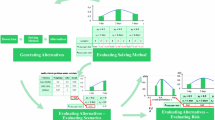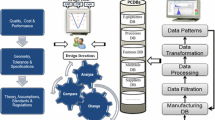Abstract
A value-risk based decision-making tool is proposed for performance assessment of manufacturing scenarios. For this purpose, values (i.e. qualitative objective statements) and concerns (i.e. qualitative risk statements) of stakeholders in any given manufacturing scenario are first identified and are made explicit via objective and risk modeling. Next, performance and risk measures are derived from the corresponding objective and risk models to evaluate the scenario under study. After that, upper and lower bounds, and target value is defined for each measure in order to determine goals and constraints for the given scenario. Because of the multidimensionality nature of performance, the identified objectives and risks, and so, their corresponding measures are usually numerous and heterogeneous in nature. These measures are therefore consolidated to obtain a global performance indicator of value and global indicator of risk while keeping in views the inter-criteria influences. Finally, the global indicators are employed to develop minimum acceptable value and maximum acceptable risk for the scenario under study and plotted on the VR-Graph to demarcate zones of “highly desirable”, “feasible”, “and risky” as well as the “unacceptable” one. The global scores of the indicators: (value-risk) pair of the actual scenario is then plotted on the defined VR-Graph to facilitate decision-making by rendering the scenarios’ performance more visible and clearer. The proposed decision-making tool is illustrated with an example from manufacturing setup in the process context but it can be extended to product or systems evaluation.












Similar content being viewed by others
References
Abdi, M. R. (2009). Fuzzy multi-criteria decision model for evaluating reconfigurable machines. International Journal of Production Economics, 117(1), 1–15.
Amid, A., Ghodsypour, S. H., & O’Brien, C. (2009). A weighted additive fuzzy multi-objective model for the supplier selection problem under price breaks in a supply Chain. International Journal of Production Economics, 121(2), 323–332.
Amoako-Gyampah, K., & Acquaah, M. (2008). Manufacturing strategy, competitive strategy and firm performance: An empirical study in a developing economy environment. International Journal of Production Economics, 111(2), 575–592.
Anselmetti, B. (2008). Manuel de tolérancement: (Vol. 2). Bases de la cotation fonctionnelle: Hermès Science Publications, Paris (in French).
Bana e Costa, C., De Corte, J.-M., & Vansnick, J.-C. (2005). On the mathematical foundation of MACBETH. In Multiple criteria decision analysis: State of the art surveys (pp. 409–437).
Bana e Costa, C. A., De Corte, J.-M., & Vansnick, J.-C. (2012). MACBETH. International Journal of Information Technology and Decision Making, 11(02), 359–387.
Banks, J. (1998). Handbook of simulation: Principles, methodology, advances, applications, and practice (1st ed.). London: Wiley-Interscience.
Beliakov, G., Pradera, A., & Calvo, T. (2010). Aggregation functions: A guide for practitioners. Berlin, Heidelberg: Springer.
Berrah, L. (2002). L’indicateur de performance: Concepts et applications. Editions Cépaduès.
Bitton, M. (1990). ECOGRAI: Méthode de conception et d’implantation de systèmes de mesure de performances pour organisations industrielles. Doctoral dissertation, University of Bordeaux, France.
Bosilj-Vuksic, V., Ceric, V., & Hlupic, V. (2007). Criteria for the evaluation of business process simulation tools. Interdisciplinary Journal of Information, Knowledge, and Management, 2, 73–88.
Chan, F. T. S., Jiang, B., & Tang, N. K. H. (2000). The development of intelligent decision support tools to aid the design of flexible manufacturing systems. International Journal of Production Economics, 65(1), 73–84.
Clivillé, V., Berrah, L., & Mauris, G. (2007). Quantitative expression and aggregation of performance measurements based on the MACBETH multi-criteria method. International Journal of Production Economics, 105(1), 171–189.
Cokins, G. (2012). Kaplan and Norton’s future vision of the Balanced Scorecard. Closing the Intelligence Gap. http://blogs.sas.com/content/cokins/2012/04/17/kaplan-and-nortons-future-vision-of-the-balanced-scorecard. Accessed Jan 21, 2013
Curtis, B., Kellner, M., & Over, J. (1992). Process modeling. Communications of the ACM, 35(9), 75–90.
Demirtas, E. A., & Üstün, Ö. (2008). An integrated multi-objective decision making process for supplier selection and order allocation. Omega, 36(1), 76–90.
Dixon, J. R., Nanni, A. J., & Vollmann, T. E. (1990). The new performance challenge: Measuring operations for world-class competition. Illinois: Dow Jones-Irwin Homewood.
Ducq, Y., & Vallespir, B. (2005). Definition and aggregation of a performance measurement system in three aeronautical workshops using the ECOGRAI method. Production Planning and Control, 16(2), 163–177.
Durand, T. (1993). Economy of scope, added value chain and cost dynamics: A tentative optimization model. International Journal of Production Economics, 29, 237–247.
Ertay, T., & Ruan, D. (2005). Data envelopment analysis based decision model for optimal operator allocation in CMS. European Journal of Operational Research, 164(3), 800–810.
Etienne, A. (2007). Intégration Produit/Process par les concepts d’activités et de caractéristiques clés-Application à l’optimisation de l’allocation des tolérances géométriques. Doctoral dissertation, University of Paul Verlain, Metz, France.
Ertuğrul, İ., & Karakaşoğlu, N. (2009). Performance evaluation of Turkish cement firms with fuzzy analytic hierarchy process and TOPSIS methods. Expert Systems with Applications, 36(1), 702– 715.
Farahani, R. Z., & Asgari, N. (2007). Combination of MCDM and covering techniques in a hierarchical model for facility location: A case study. European Journal of Operational Research, 176(3), 1839–1858.
Fortuin, L. (1988). Performance indicators: Why, where and how? European Journal of Operational Research, 34(1), 1–9.
Globerson, S. (1985). Issues in developing a performance criteria system for an organization. International Journal of Production Research, 23(4), 639–646.
Grabisch, M., & Labreuche, C. (2010). A decade of application of the Choquet and Sugeno integrals in multi-criteria decision aid. Annals of Operations Research, 175(1), 247–286.
Greco, S. (2004). Multiple criteria decision analysis: State of the art surveys. New York: Springer.
Hao, Q., & Shen, W. (2008). Implementing a hybrid simulation model for a Kanban-based material handling system. Robotics and Computer-Integrated Manufacturing, 24(5), 635–646.
Ho, W., Xu, X., & Dey, P. K. (2010). Multi-criteria decision making approaches for supplier evaluation and selection: A literature review. European Journal of Operational Research, 202(1), 16–24.
Jablonsky, J. (2007). Measuring the efficiency of production units by AHP models. Mathematical and Computer Modelling, 46(7–8), 1091–1098.
Jolai, F., Rezaee, M. J., & Vazifeh, A. (2009). Multi-criteria decision making for assembly line balancing. Journal of Intelligent Manufacturing, 20, 113–121.
Kaplan, S., & Garrick, B. J. (1981). On the quantitative definition of risk. Risk Analysis, 1(1), 11–27.
Kaplan, R. S., & Norton, D. P. (1992). The balanced scorecard—measures that drive performance. Harvard Business Review, 70(1), 71–79.
Kaplan, R. S., & Norton, D. P. (1996). Using the balanced scorecard as a strategic management system. Harvard Business Review, 74(1), 75–85.
Kaplan, R. S., & Norton, D. P. (2004). Measuring the strategic readiness of intangible assets. Harvard Business Review, 82, 52–63.
Keeney, R. L., & Raïffa, H. (1993). Decisions with multiple objectives: Preferences and value tradeoffs. Cambridge: Cambridge University Press.
Keeney, R. (1996). Value-focused thinking: Identifying decision opportunities and creating alternatives. European Journal of Operational Research, 92(3), 537–549.
Kirkwood, C. W., & Sarin, R. K. (1980). Preference conditions for multiattribute value functions. Operations Research, 28(1), 225–232.
Labreuche, C., & Grabisch, M. (2003). The Choquet integral for the aggregation of interval scales in multicriteria decision making. Fuzzy Sets and Systems, 137, 11–26.
Larson, N., & Kusiak, A. (1996a). System reliability methods for analysis of process models. Integrated Computer-Aided Engineering, 3, 279–291.
Larson, N., & Kusiak, A. (1996b). Managing design processes: A risk assessment approach. IEEE Transactions on Systems, Man, and Cybernetics: Systems and Humans, 26(6), 749–759.
Li, T.-S., & Huang, H.-H. (2009). Applying TRIZ and Fuzzy AHP to develop innovative design for automated manufacturing systems. Expert Systems with Applications, 36(4), 8302–8312.
Low, C., Yip, Y., & Wu, T.-H. (2006). Modelling and heuristics of FMS scheduling with multiple objectives. Computers and Operations Research, 33, 674–694.
Lynch, R., & Cross, K. (1995). Measure Up!: Yardsticks for continuous improvement. Cambridge: Blackwell Business.
Lynch, R. L., & Cross, K. F. (1992). The SMART way to define and sustain success. National Productivity Review, 8(1), 23–33.
Malakooti, B. (2011). Systematic decision process for intelligent decision making. Journal of Intelligent Manufacturing, 22, 627–642.
Maskell, B. H. (1991). Performance measurement for world class manufacturing: A model for American companies (1st ed.). Cambridge: Productivity Press.
Mun, J. (2006). Modeling risk: Applying Monte Carlo simulation, real options analysis, forecasting, and optimization techniques. Wiley Finance.
Neely, A. D., Adams, C., & Kennerley, M. (2002). The performance prism: The scorecard for measuring and managing business success. London: Financial Times Prentice Hall.
Neiger, D., Churilov, L., & Flitman, A. (2008). Value-focused business process engineering: A systems approach: With applications to human resource management. Berlin: Springer.
Özcan, U., & Toklu, B. (2009). Multiple-criteria decision-making in two-sided assembly line balancing: A goal programming and a fuzzy goal programming models. Computers and Operations Research, 36, 1955–1965.
Pang, B., & Bai, S. (2013). An integrated fuzzy synthetic evaluation approach for supplier selection based on analytic network process. Journal of Intelligent Manufacturing, 24(1), 163–174.
Pokharel, S. (2008). A two objective model for decision making in a supply chain. International Journal of Production Economics, 111(2), 378–388.
Rao, R. V. (2011). Advanced modeling and optimization of manufacturing processes international research and development. London, New York: Springer.
Robinson, S., Brooks, R., & Kotiadis, K. (2010). Conceptual modeling for discrete-event simulation (1st ed.). Boca Raton, FL, USA: CRC Press.
Santos, S. P., Belton, V., & Howick, S. (2002). Adding value to performance measurement by using system dynamics and multicriteria analysis. International Journal of Operations and Production Management, 22(11), 1246–1272.
SCOR. (2012). SCOR Version 11.0. http://www.supply-chain.org. Accessed Dec 7, 2013
Shah, L. A. (2012). Value/risk-based performance evaluation of industrial systems. Doctoral dissertation, Ecole nationale supérieure d’arts et métiers-ENSAM, France.
Shah, L., Etienne, A., Siadat, A., & Vernadat, F. (2012). (Value, risk)-based performance evaluation of manufacturing processes. Information Control Problems in Manufacturing, 14(1), 1586–1591.
Sienou, A. (2009). Proposition d’un cadre méthodologique pour le management intégré des risques et des processus d’entreprise. Doctoral. dissertation, University of Toulouse, France.
Sormaz, D. N., & Khoshnevis, B. (2003). Generation of alternative process plans in integrated manufacturing systems. Journal of Intelligent Manufacturing, 14(6), 509–526.
Taha, Z., & Rostam, S. (2012). A hybrid fuzzy AHP-PROMETHEE decision support system for machine tool selection in flexible manufacturing cell. Journal of Intelligent Manufacturing, 23(6), 2137–2149.
Tseng, F.-M., Chiu, Y.-J., & Chen, J.-S. (2009). Measuring business performance in the high-tech manufacturing industry: A case study of Taiwan’s large-sized TFT-LCD panel companies. Omega, 37(3), 686–697.
Tuncel, G., & Alpan, G. (2010). Risk assessment and management for supply chain networks: A case study. Computers in Industry, 61(3), 250–259.
Vernadat, F., Shah, L., Etienne, A., & Siadat, A. (2013). VR-PMS: A new approach for performance measurement and management of industrial systems. International Journal of Production Research, 51(23–24), 7420–7438.
Wernz, C., & Deshmukh, A. (2012). Unifying temporal and organizational scales in multiscale decision-making. European Journal of Operational Research, 223(3), 739–751.
Yu, V. F., & Hu, K.-J. (2010). An integrated fuzzy multi-criteria approach for the performance evaluation of multiple manufacturing plants. Computers and Industrial Engineering, 58(2), 269–277.
Zolghadri, M., Olivier, C., & Bourrières, J.-P. (2008). Close-optimal production and procurement policy for a X-network of added value using lexicographic linear goal programming. Computers and Industrial Engineering, 54(4), 821–839.
Author information
Authors and Affiliations
Corresponding author
Rights and permissions
About this article
Cite this article
Shah, L.A., Etienne, A., Siadat, A. et al. Decision-making in the manufacturing environment using a value-risk graph. J Intell Manuf 27, 617–630 (2016). https://doi.org/10.1007/s10845-014-0895-6
Received:
Accepted:
Published:
Issue Date:
DOI: https://doi.org/10.1007/s10845-014-0895-6




